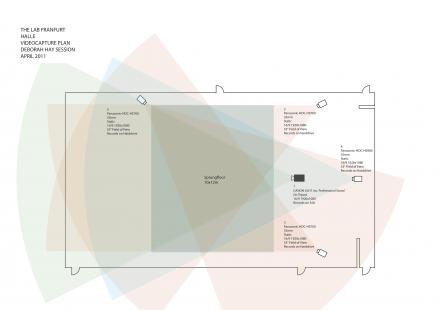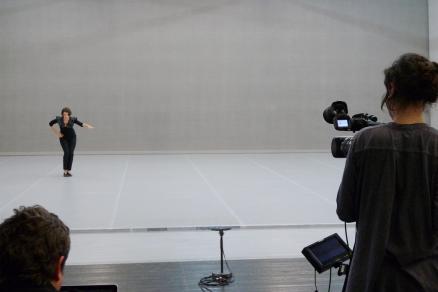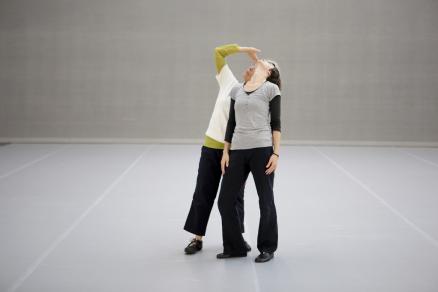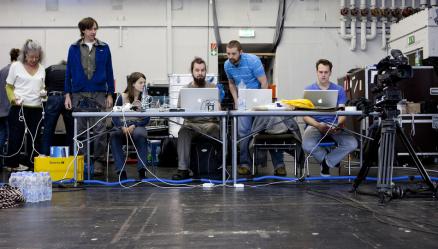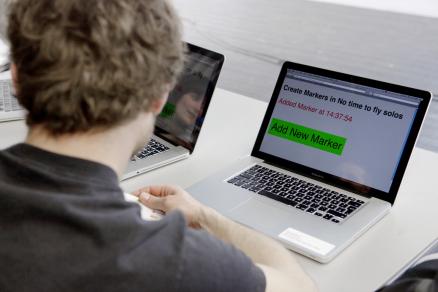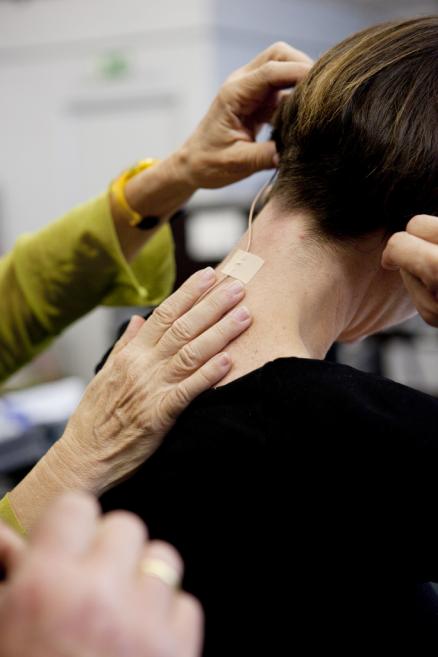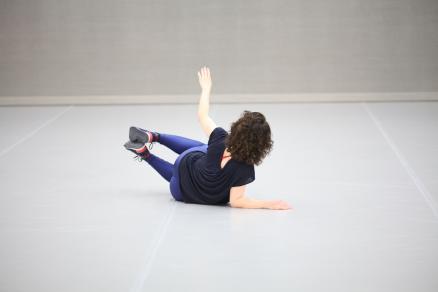Deborah Hay Score Project: Solo Filming
Deborah Hay Score Project:Solo FilmingFrom 18-23 April 2011, the filming of the solos of Ros Warby, Juliette Mapp and Jeanine Durning took place in The Frankfurt Lab. Four cameras were positioned at high angles around the space: one front ‘master shot’ position, two from the front diagonals and one from the rear diagonal. A fifth camera was on a tripod and used to follow the dancers. Click here for a closer view of the image to the right, including camera models. |
|
|
As mentioned in the previous report (Deborah Hay Test Filming) the score team planned to record as many versions of the performance as possible. Ros, Juliette and Jeanine each performed their versions of the written score No Time to Fly several times. When practicing their adaptations of Deborah’s choreography, the performers do not repeat the same movements in time and space. |
|
|
Deborah has published notes on her website about these adaptations and the “streaming perceptual challenges” for the performers. “… No matter how detailed or broad the language, between the written score and the performance are hidden elements that cannot be defined because my ‘verbal dialectic’ is deliberately powerless to define the performer’s movement dialectic.” Searching for a means to render hidden elements visible was one of the goals of the score team. |
|
|
One of the methods used by the score team to document each solo involved the use of Piecemaker, a software in development by Motion Bank that can be used to annotate video in real-time. Each day of the filming of the solo adaptations small groups were invited to watch and to set a mark each time they noticed change occurring in the performance. |
|
|
These groups had never seen the dance and were not given the written score before. The instructions left it up to them to mark changes in the dance. The score team is now using this data to look for the overlaps between where changes are indicated in the written score with what the ‘outside observer’ can see. |
|
|
High fidelity audio recordings were also made of each performance. This involved setting up a system of recording both the sounds in the space as well as the vocalisations of each performer which are also indicated in the written score, for example “I open my mouth and hear a holy song rise up out of me.” (No Time to Fly score p. 11) Post-production work after the filming of the solo adaptations will involve the sychronisation of video, marker and audio data of each version. This work provides the raw material to be studied for patterns that can be drawn out in the design process. Additionally, computer vision algorithms will be applied to data derived from the video recordings to provide the position of the dancer in space. This will make it possible to study the differences between each version — of each solo of each performer and the differences between the solos of the three performers. More about this process will be described in future reports. |
|
|
By the end of the week Ros, Juliette and Jeanine had performed their solo adaptations seven times each, providing the score team with recordings of 21 versions of the same choreography No Time to Fly to take away for analysis. Deborah and the performers will return in September and October to develop a trio based on their solo adaptations with the new title As Holy Sites Go. |
|
|
Svenja Kahn from the Fraunhofer Institute explains the computer vision technologies used to extract the 3D pathway information from the solo adaptations of No Time to Fly. This information played an essential role in Motion Bank's analysis and synthesis of visual material based on Deborah Hay's choreographic approach. |
|
Deborah Hay's Process Documentation Pages:
http://motionbank.org/en/event/deborah-hay-test-filming
http://motionbank.org/en/event/deborah-hay-score-project-solo-filming
http://motionbank.org/en/event/deborah-hay-guest-performances
http://motionbank.org/en/event/deborah-hay-final-filming
http://motionbank.org/en/event/deborah-hay-score-production-session-no-1
http://motionbank.org/en/event/deborah-hay-score-production-session-austin
http://motionbank.org/en/event/tanzkongress-deborah-hay-beta-release-workshops
INFO
As a response to the COVID-19 / Corona situation we just opened our research system (including Piecemaker and MoSys) for dance education and practice.
This year Motion Bank celebrates it's 10 anniversary. As soon as it becomes possible to make final plans we will release information about these.
Please consider subscribing to our newsletter.

